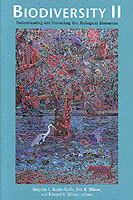"The book before you...carries the urgent warning that we are rapidly altering and destroying the environments that have fostered the diversity of life forms for more than a billion years."
With those words, Edward O. Wilson opened the landmark volume Biodiversity (National Academy Press, 1988). Despite this and other such alarms, species continue to vanish at a rapid rate, taking with them their genetic legacy and potential benefits. Many disappear before they can even be identified.
Biodiversity II is a renewed call for urgency. This volume updates readers on how much we already know and how much remains to be identified scientifically. It explores new strategies for quantifying, understanding, and protecting biodiversity, including:
- New approaches to the integration of electronic data, including a proposal for a U.S. National Biodiversity Information Center.
- Application of techniques developed in the human genome project to species identification and classification.
- The Gap Analysis Program of the National Biological Survey, which uses layered satellite, climatic, and biological data to assess distribution and better manage biodiversity.
- The significant contribution of museum collections to identifying and categorizing species, which is essential for understanding ecological function and for targeting organisms and regions at risk.
The book describes our growing understanding of how megacenters of diversity (e.g., rainforest insects, coral reefs) are formed, maintained, and lost; what can be learned from mounting bird extinctions; and how conservation efforts for neotropical primates have fared. It also explores ecosystem restoration, sustainable development, and agricultural impact.
Biodiversity II reinforces the idea that the conservation of our biological resources is within reach as long as we pool resources; better coordinate the efforts of existing institutions—museums, universities, and government agencies—already dedicated to this goal; and enhance support for research, collections, and training. This volume will be important to environmentalists, biologists, ecologists, educators, students, and concerned individuals.
Table of Contents
- Front Matter
- 1 Introduction
- Part I The Meaning and Value of Biodiversity: 2 Biodiversity: What Is It?
- 3 Biodiversity: Why Is It Important?
- Part II Patterns of the Biosphere: How Much Biodiversity Is There?: 4 Biodiversity at Its Utmost: Tropical Forest Beetles
- 5 Measuring Global Biodiversity and Its Decline
- 6 Butterfly Diversity and a Preliminary Comparison with Bird and Mammal Diversity
- 7 The Global Biodiversity of Coral Reefs: A Comparison with Rain Forests
- 8 Common Measures for Studies of Biodiversity: Molecular Phylogeny in the Eukaryotic Microbial World
- Part III Threats to Biodiversity: What Have We Lost and What Might We Lose?: 9 The Rich Diversity of Biodiversity Issues
- 10 Human-Caused Extinction of Birds
- 11 Global Warming and Plant Species Richness: A Case Study of the Paleocene/Eocene Boundary
- 12 Plant Response to Multiple Environmental Stresses: Implications for Climatic Change and Biodiversity
- Part IV Understanding and Using Biodiversity: 13 Names: The Key to Biodiversity
- 14 Systematics: A Keystone to Understanding Biodiversity
- 15 Biodiversity and Systematics: Their Applications to Agriculture
- 16 Snout Moths: Unraveling the Taxonomic Diversity of a Speciose Group in the Neotropics
- 17 Phylogeny and Historical Reconstruction: Host-Parasite Systems as Keystones in Biogeography and Ecology
- 18 Comparative Behavioral and Biochemical Studies of Bowerbirds and the Evolution of Bower-Building
- Part V Building Toward a Solution: New Directions and Applications: 19 Microbial Biodiversity and Biotechnology
- 20 The Impact of Rapid Gene Discovery Technology on Studies of Evolution and Biodiversity
- 21 Initial Assessment of Character Sets from Five Nuclear Gene Sequences in Animals
- 22 Gap Analysis for Biodiversity Survey and Maintenance
- 23 Conservation of Biodiversity in Neotropical Primates
- 24 Using Marine Invertebrates to Establish Research and Conservation Priorities
- 25 Ecological Restoration and the Conservation of Biodiversity
- 26 Tropical Sustainable Development and Biodiversity
- 27 Wildland Biodiversity Management in the Tropics
- Part VI Getting the Job Done: Institutional, Human, and Informational Infrastructure: 28 Taxonomic Preparedness: Are We Ready to Meet the Biodiversity Challenge?
- 29 Museums, Research Collections and the Biodiversity Challenge
- 30 Resources for Biodiversity in Living Collections and the Challenges of Assessing Microbial Biodiversity
- 31 Integration of Data for Biodiversity Initiatives
- 32 Information Management for Biodiversity: A Proposed U.S. National Biodiversity Information Center
- Part VII Conclusions: 33 Santa Rosalia, the Turning of the Century, and a New Age of Exploration
- Photo Credits
- Index

















